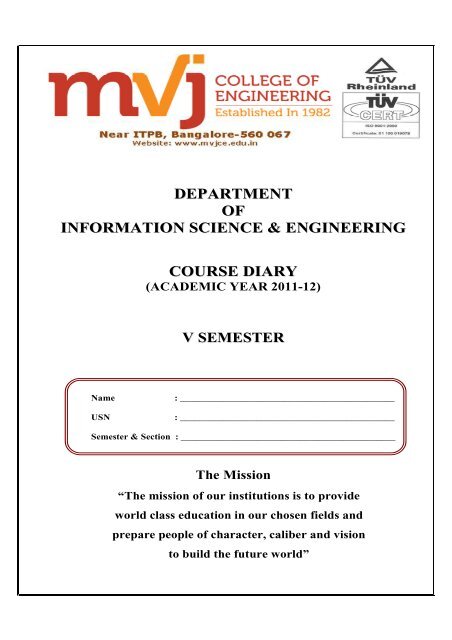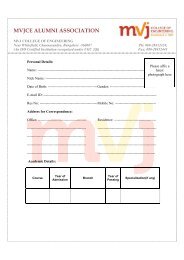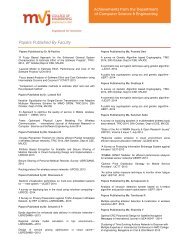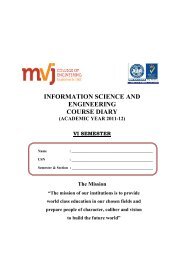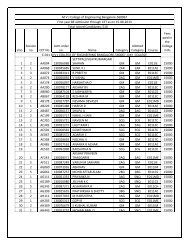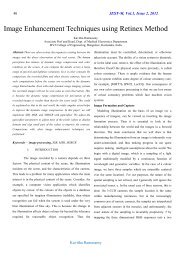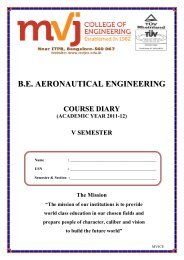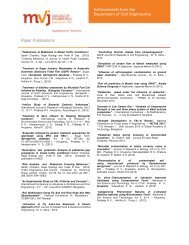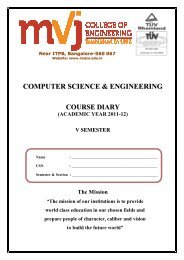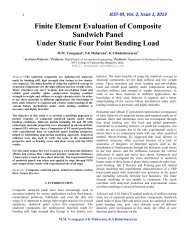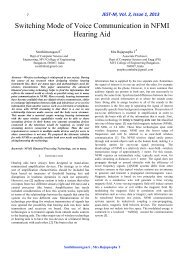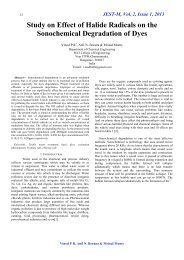5 SEM COURSE DIARY - MVJ College of Engineering
5 SEM COURSE DIARY - MVJ College of Engineering
5 SEM COURSE DIARY - MVJ College of Engineering
- No tags were found...
You also want an ePaper? Increase the reach of your titles
YUMPU automatically turns print PDFs into web optimized ePapers that Google loves.
DEPARTMENTOFINFORMATION SCIENCE & ENGINEERING<strong>COURSE</strong> <strong>DIARY</strong>(ACADEMIC YEAR 2011-12)V <strong>SEM</strong>ESTERNameUSN: _____________________________________________: _____________________________________________Semester & Section : _____________________________________________The Mission“The mission <strong>of</strong> our institutions is to provideworld class education in our chosen fields andprepare people <strong>of</strong> character, caliber and visionto build the future world”
INDEXSNO SUB CODE SUBJECT1 06IS51 SOFTWARE ENGINEERING2 06CS52 SYSTEM SOFTWARE3 06CS53 OPERATING SYSTEMS4 06CS54 DATABASE MANAGEMENT SYSTEMS5 06CS55 COMPUTER NETWORKS I6 06CS56 FORMAL LANGUAGES AND AUTOMATA THEORY7 06CSL57 DATABASE APPLICATIONS LABORATORY8 06CSL58 ALGORITHMS LABORATORY
SOFTWARE ENGINEERINGSubject Code: 06IS51No. <strong>of</strong> Lecture Hrs/ Week:04Total No. <strong>of</strong> Lecture Hours: 52IA Marks:25Exam Hours:03Exam Marks:100PART - AUNIT - 1OVERVIEW: Introduction: FAQ's about s<strong>of</strong>tware engineering, Pr<strong>of</strong>essional and ethicalresponsibility. Socio-Technical systems: Emergent system properties; Systems engineering;Organizations, people and computer systems; Legacy systems.6 HoursUNIT - 2CRITICAL SYSTEMS, SOFTWARE PROCESSES: Critical Systems: A simple safety-criticalsystem; System dependability; Availability and reliability. S<strong>of</strong>tware Processes: Models, Processiteration, Process activities; The Rational Unified Process; Computer-Aided S<strong>of</strong>tware<strong>Engineering</strong>.7 HoursUNIT - 3REQUIREMENTS: S<strong>of</strong>tware Requirements: Functional and Non-functional requirements; Userrequirements; System requirements; Interface specification; The s<strong>of</strong>tware requirementsdocument. Requirements <strong>Engineering</strong> Processes: Feasibility studies; Requirements elicitationand analysis; Requirements validation; Requirements management.6 HoursUNIT - 4System models, Project Management: System Models: Context models; Behavioral models; Datamodels; Object models; Structured methods. Project Management: Management activities;Project planning; Project scheduling; Risk management.7 HoursPART - BUNIT - 5SOFTWARE DESIGN: Architectural Design: Architectural design decisions; Systemorganization; Modular decomposition styles; Control styles. Object-Oriented design: Objects andObject Classes; An Object-Oriented design process; Design evolution. 7 HoursUNIT - 6 DEVELOPMENT: Rapid S<strong>of</strong>tware Development: Agile methods; Extremeprogramming; Rapid application development. S<strong>of</strong>tware Evolution: Program evolutiondynamics; S<strong>of</strong>tware maintenance; Evolution processes; Legacy system evolution. 6 HoursUNIT - 7VERIFICATION AND VALIDATION: Verification and Validation: Planning; S<strong>of</strong>twareinspections; Automated static analysis; Verification and formal methods. S<strong>of</strong>tware testing:System testing; Component testing; Test case design; Test automation. 7 HoursUNIT - 8
LESSON-PLANSubject : SOFTWARE ENGINEERING Semester : VSubject Code : 06IS51Exam Hours : 3 Exam Marks : 100Total Hours : 52 IA Marks : 25SlNOChapterTopics to be covered1Introduction: FAQ’s about s<strong>of</strong>tware engineering2 Pr<strong>of</strong>essional and ethical responsibility3 (1) Socio-Technical systems: Emergent system properties4 Introduction Systems engineering5 Organizations, people and computer systems6 Legacy systems78 System dependabilityCritical Systems: A simple safety-critical system9 (2) Availability and reliability10CriticalSystems,S<strong>of</strong>twareS<strong>of</strong>tware Processes: Models11 Processes Process iteration, Process activities12 The Rational Unified Process13 Computer-Aided S<strong>of</strong>tware <strong>Engineering</strong>14S<strong>of</strong>tware Requirements: Functional and Non-functional requirements15 User requirements; System requirements, Interface specification16 (3) The s<strong>of</strong>tware requirements document17 Requirements Requirements <strong>Engineering</strong> Processes: Feasibility studies18 Requirements elicitation and analysis19 Requirements validation; Requirements management20 (4) System Models: Context modelsSystem21 Models.Project Behavioral modelsManagement
22 Data models23 Object models24 Structured methods25 Project Management: Management activities; Project planning26 Project scheduling; Risk management27Architectural Design: Architectural design decisions28 System organization29 Modular decomposition styles30(5)S<strong>of</strong>tware DesignControl styles31 Object-Oriented design: Objects and Object Classes32 An Object- Oriented design process33 Design evolution34Rapid S<strong>of</strong>tware Development: Agile methods35 Extreme programming; Rapid application development36 (6) S<strong>of</strong>tware Evolution: Program evolution dynamics37 Development S<strong>of</strong>tware maintenance38 Evolution processes39 Legacy system evolution40Verification and Validation: Planning41 S<strong>of</strong>tware inspections42(7)Automated static analysis43 Verification and Verification and formal methods44ValidationS<strong>of</strong>tware testing: System testing45 Component testing46 Test case design; Test automation47Managing People: Selecting staff48 Motivating people, Managing people49(8)The People Capability Maturity Model50 Management S<strong>of</strong>tware Cost Estimation: Productivity51 Estimation techniques; Algorithmic cost modeling52 Project duration and staffingQUESTION BANK
Class: VI Semester Hours / Week: 4Subject: 06IS51– S<strong>of</strong>tware <strong>Engineering</strong> Total Hours: 52IA Marks: 25 Total marks: 1001. What is Requirement <strong>Engineering</strong> ?2. What are Functinoal and Non Functional Requirements in S<strong>of</strong>tware Enginering ?3. What is SRS ?4. What are the Different types <strong>of</strong> Architectures in S<strong>of</strong>tware <strong>Engineering</strong> ?5. What are use cases and class diagrams in S<strong>of</strong>tware <strong>Engineering</strong> ?6. What are sequence diagram ? What are package diagram ? What are collaborationdiagram ?7. What is a Good S<strong>of</strong>tware Design ?8. What are Design patterns ?9. What are the characteristics <strong>of</strong> good design ? Name some Design Tools ?10. What is SDLC ? What are the various SDLC models ? Explain them11. What is RUP and PSP ?12. What are the Different types <strong>of</strong> Testing ? How to design a Test Case ?13. With a neat diagram explain the different stages <strong>of</strong> Requirement <strong>Engineering</strong> process.14. Why elicitation and analysis a difficult process. Explain giving reasons.15. Explain in detail about View Point Oriented Elicitation.16. Explain with examples the different types <strong>of</strong> functional and non-functional requirements.17. Write the differences between Evolutionary and Throw-away Prototyping.18. What is Prototyping? What are the benefits <strong>of</strong> developing a prototype?19. Give description about the following: 1.domain requirements 2.Enduring requirements3. Data Dictionary 4.Design abstractions 5. S/W reliability20. Can you name some limitations <strong>of</strong> a web environment vs. a Windows environment?21. What is rapid prototyping technique? Explain the different types <strong>of</strong> rapid prototypingtechniques.22. Explain different types <strong>of</strong> user interaction styles. Give advantages, disadvantages.23. Write in detail about object oriented design process.24. What are the two approaches to control models at the Architectural level?25. What is modular decomposition? Explain dataflow model <strong>of</strong> an invoice processingsystem.26. Draw and explain sequence diagram and state diagram for typical weather station.27. What are the guidelines to be followed while using color in a user interface?28. With an example describe the repository model and give its advantages anddisadvantages.29.Explain the structure <strong>of</strong> s/w requirement s document.30. Illustrate with two examples for object and object class.31. What is CASE workbench? Describe the tools included in an analysis and designworkbench.32. Write a note about user interface design principles.33. Describe an s/w process with Throwaway prototyping. What are the problems with thisapproach?34 Define Bug Life Cycles? What is Metrics?35 What is a Test procedure?36 What is the difference between SYSTEM testing and END-TO-END testing?37 What is Tractability Matrix? Is there any interchangeable term for Traceability Matrix?Are Tractability Matrix and Test Matrix same or Different?
38 What is the difference between an exception and an error?39 Correct bug tracking process - Reporting, Re-testing, Debugging?40 What is the difference between bug and defect?41 How much time is/should be allocated for testing out <strong>of</strong> total Development time based onindustry standards?42 What are test bugs?43 Define Quality - bug free, Functionality working or both?44 What is the purpose <strong>of</strong> s<strong>of</strong>tware testing’s - Bug removal, System’s functionality working,quality or all?45 What is the major difference between Web services & client server environment?46 What is Scalability testing? Which tool is used?47 What's your favorite Design Pattern?48 What is custom object? What it contains. Difference between custom & standard objects.49 Which debugging window allows you to see the methods called in the order they werecalled?50 What is the difference between shadow and override?51 What is class? What is object explain it. Describe the principles <strong>of</strong> OOPS.What is OOPS?52 Which items do you normally place under version control?53 How can you make sure that team members know who changed what in a s<strong>of</strong>twareproject?54 Do you know the differences between tags and branches? When do you use which?55 How would you manage changes to technical documentation, like the architecture <strong>of</strong> aproduct?56 How do you deal with changes that a customer wants in a released product?57 Are there differences in managing versions and releases?58 How many <strong>of</strong> the three variables scope, time and cost can be fixed by the customer?59 Who should make estimates for the effort <strong>of</strong> a project? Who is allowed to set thedeadline?60 Which kind <strong>of</strong> diagrams do you use to track progress in a project?61What is the difference between iteration and an increment?
Subject Code:06CS52No. <strong>of</strong> Lecture Hrs./ Week:04Total No. <strong>of</strong> Lecture Hours:52SYSTEM SOFTWAREIA Marks:25Exam Hours:03Exam Marks:100PART - AUNIT - 1MACHINE ARCHITECTURE: Introduction, System S<strong>of</strong>tware and Machine Architecture,Simplified Instructional Computer (SIC) - SIC Machine Architecture, SIC/XE MachineArchitecture, SIC Programming Examples6 HoursUNIT - 2AS<strong>SEM</strong>BLERS - 1: Basic Assembler Function - A Simple SIC Assembler, AssemblerAlgorithm and Data Structures, Machine Dependent Assembler Features - Instruction Formats &Addressing Modes, Program Relocation.6 HoursUNIT - 3AS<strong>SEM</strong>BLERS - 2: Machine Independent Assembler Features – Literals, Symbol-DefinitionStatements, Expression, Program Blocks, Control Sections and Programming Linking,Assembler Design Operations - One-Pass Assembler, Multi-Pass Assembler, ImplementationExamples - MASM Assembler.6 HoursUNIT - 4LOADERS AND LINKERS: Basic Loader Functions - Design <strong>of</strong> an Absolute Loader, A SimpleBootstrap Loader, Machine-Dependent Loader Features – Relocation, Program Linking,Algorithm and Data Structures for a Linking Loader; Machine-Independent Loader Features -Automatic Library Search, Loader Options, Loader Design Options - Linkage Editor, DynamicLinkage, Bootstrap Loaders, Implementation Examples - MS-DOS Linker. 8 HoursPART - BUNIT - 5EDITORS AND DEBUGGING SYSTEMS: Text Editors - Overview <strong>of</strong> Editing Process, UserInterface, Editor Structure, Interactive Debugging Systems - Debugging Functions andCapabilities, Relationship With Other Parts Of The System, User-Interface Criteria. 6 HoursUNIT - 6MACRO PROCESSOR: Basic Macro Processor Functions - Macro Definitions and Expansion,Macro Processor Algorithm and Data Structures, Machine-Independent Macro ProcessorFeatures - Concatenation <strong>of</strong> Macro Parameters, Generation <strong>of</strong> Unique Labels, Conditional MacroExpansion, Keyword Macro Parameters, Macro Processor Design Options - Recursive MacroExpansion, General-Purpose Macro Processors, Macro Processing Within Language Translators,Implementation Examples - MASM Macro Processor, ANSI C Macro Processor.8 HoursUNIT - 7LEX AND YACC – 1: Lex and Yacc - The Simplest Lex Program, Recognizing Words WithLEX, Symbol Tables, Grammars, Parser-Lexer Communication, The Parts <strong>of</strong> Speech Lexer, AYACC Parser, The Rules Section, Running LEX and YACC, LEX and Hand- Written Lexers,Using LEX - Regular Expression, Examples <strong>of</strong> Regular Expressions, A Word Counting Program,Parsing a Command Line.6 Hours
UNIT - 8LEX AND YACC - 2: Using YACC - Grammars, Recursive Rules, Shift/Reduce Parsing, WhatYACC Cannot Parse, A YACC Parser - The Definition Section, The Rules Section, SymbolValues and Actions, The LEXER, Compiling and Running a Simple Parser, ArithmeticExpressions and Ambiguity, Variables and Typed Tokens.6 HoursTEXT BOOKS:1. System S<strong>of</strong>tware – Leland.L.Beck, 3rd Edition, Addison-Wesley, 1997.2. Lex and Yacc - John.R.Levine, Mason and Doug Brown, O'Reilly, SPD, 1998.REFERENCE BOOK:1. System Programming and Operating Systems – D.M.Dhamdhere, 2nd Edition, TataMcGraw - Hill, 1999.
M.V.J. COLLEGE OF ENGINEERINGDepartment <strong>of</strong> Information Science & <strong>Engineering</strong>LESSON PLANClass : V Semester Hours / Week: 4Subject : System S<strong>of</strong>tware Sub code: 06CS52Total Hours : 52 (62 CLASSES) IA Marks : 25S.No CHAPTERHour.NoTOPICS TO BE COVEREDPART-A1 Machine Architecture 1 Introduction,2 .System s<strong>of</strong>tware and machine architecture.3 (SIC)-Simplified Instructional computer4 (SIC)-Simplified Instructional computer5 SIC/XE machine architecture6 SIC/XE machine architecture7 SIC programming examples8 SIC programming examples2 Assemblers-1 9 Basic assembler function10 A simple SIC assembler11 Assembler algorithm and data structures12 Assembler algorithm and data structures13 Machine dependent assembler features14 Instruction formats and addressing modes15 Instruction formats and addressing modes16 Program relocation3 Assemblers-2 17 Machine independent assembler features-Literals18 Symbol-Definition statements,Expressions19 Program blocks,control sections and program linking20 Program blocks,control sections and program linking21 Assembler design operations-one pass assembler22 Assembler design operations-one pass assembler23 Multi pass assembler24 Implementation examples-MASM assembler.4 Loaders and linkers 25 Basic Loader Functions - Design <strong>of</strong> an AbsoluteLoader,26 A Simple Bootstrap Loader, Machine-DependentLoader Features27 Relocation, Program Linking, Algorithm and DataStructures for a Linking Loader;28 Relocation, Program Linking, Algorithm and DataStructures for a Linking Loader;29 Machine-Independent Loader Features30 Automatic Library Search,31 Loader Options, Loader Design Options32 Linkage Editor, Dynamic Linkage, Bootstrap Loaders,33 Sun OS Linker, Cray MPP Linker.
5 Editors and debuggingsystemsPART –B34 Text editors-overview <strong>of</strong> editing process35 User interface,Editor structure36 User interface,Editor structure37 Interactive debugging systems38 Debugging functions and capabilities39 Relationships with other parts <strong>of</strong> the system40 User-Interface criteria6 Macro Processor 41 Basic macro processor function-macro definitions andexpansions42 Macro processor algorithm and data structure,43 machine independent macro processor featuresconcatenation<strong>of</strong> macro parameters44 Generation <strong>of</strong> unique labels,conditional macroexpansion45 Keyword macro parameters46 Macro processor design options47 Recursive macro expansioon,General purpose macroprocessor48 Macro processor within language translators49 Implementation examples-MASM macroprocessor,ANSI C macro processor50 Implementation examples-MASM macroprocessor,ANSI C macro processor7 LEX and YACC-1 51 Lex and Yacc-The simplest Lex program,Recognizingwords with Lex52 Symbol tables,Grammars,parser lexer communication53 The parts <strong>of</strong> speech Lexer,A YACC parser54 The rules section,Running LEX and YACC,55 LEX and hand written Lexes Using Lex regularexpressions56 Examples <strong>of</strong> regular expressions57 A word counting program,Parsing a command line8 LEX and YACC-2 58 Using YACC grammars,Recursive rules59 Shift/Reduce parsing,What Yacc cannot parse60 A yacc parser-The definition section,symbol valuesand action61 The lexer,compiling and running a simple parser62 Arithmetic expressions and ambiguity Variables andtyped tokens
Model Question PaperClass: B.E. V Semester Total Hours: 52Subject: Systems S<strong>of</strong>tware Hours / week:04Subject Code: 06CS52 IA Marks: 251. Explain the concept <strong>of</strong> System S<strong>of</strong>tware and Machine Architecture2. Briefly explain SIC Machine Architecture3. Briefly explain SIC/XE Machine Architecture4. Write the instruction format <strong>of</strong> Traditional (CISC) Machines5. Briefly explain VAX Architecture & Pentium Pro Architecture6. Differentiate between JSUB and RSUB.7. Write the instruction format RISC Machines with example8. With a diagram explain Ultra SPARC Architecture9. With a diagram explain Cray T3E Architecture.10. Write a short note on basic assembler function11. Briefly explain about A Simple SIC Assembler12. With a neat example explain Assembler Algorithm and Data Structures13. Write a short note on Machine Dependent Assembler Features14. What is Instruction Formats & Addressing Modes in assemblers15. With a neat diagram Explain Program Relocation16. Write a Short on Machine Independent Assembler Features17. Explain Literals, Symbol-Definition Statements Expression with example18. How Program Blocks, Control Sections and Programming Linking in Assembler willwork give example19. Briefly Explain One-Pass Assembler20. What is Multi-Pass Assembler21. Explain about MASM Assembler, SPARC Assembler22. Write a short note on Basic Loader Functions –23. Explain Design <strong>of</strong> an Absolute Loader24. Write a algorithm for a Simple Bootstrap Loader and Explain detail25. Write Machine-Dependent Loader Features26. What is Relocation27. What is Program Linking28. Write Machine-Independent Loader Features29. Explain Automatic Library Search30. Explain Linkage Editor31. Explain briefly Bootstrap Loaders32. Explain Basic Macro Processor Functions33. Briefly explain Macro Definitions and Expansion34. Explain Macro Processor Algorithm and Data Structures35. Explain features <strong>of</strong> Machine-Independent Macro Processor36. Explain with example Concatenation <strong>of</strong> Macro Parameters37. How to Generate <strong>of</strong> Unique Labels38. Explain with example Conditional Macro Expansion39. Describe General-Purpose Macro Processors40. Explain Macro Processing Within Language Translators41. Write Lex Program to find vowels and consonants42. Define Symbol Tables43. What is Grammars44. Explain Parser-Lexer Communication
45. Define YACC Parser46. Explain the sections in YAAC Parser47. How to Run LEX and YACC48. Explain - Regular Expression Using LEX, with Examples49. Write a program to count words in a command line50. What is Shift/Reduce Parsing,
Subject Code:06CS53No. <strong>of</strong> Lecture Hrs./ Week:04Total No. <strong>of</strong> Lecture Hours:52OPERATING SYSTEMSPART - AIA Marks:25Exam Hours:03Exam Marks:100UNIT - 1INTRODUCTION TO OPERATING SYSTEMS, SYSTEM STRUCTURES: What operatingsystems do; Computer System organization; Computer System architecture; Operating Systemstructure; Operating System operations; Process management; Memory management; Storagemanagement; Protection and security; Distributed system; Special-purpose systems; Computingenvironments. Operating System Services; User - Operating System interface; System calls;Types <strong>of</strong> system calls; System programs; Operating System design and implementation;Operating System structure; Virtual machines; Operating System generation; System boot.6 HoursUNIT - 2Process Management: Process concept; Process scheduling; Operations on processes; Interprocesscommunication. Multi-Threaded Programming: Overview; Multithreading models;Thread Libraries; Threading issues. Process Scheduling: Basic concepts; Scheduling criteria;Scheduling algorithms; Multiple-Processor scheduling; Thread scheduling. 7 HoursUNIT - 3PROCESS SYNCHRONIZATION: Synchronization: The Critical section problem; Peterson’ssolution; Synchronization hardware; Semaphores; Classical problems <strong>of</strong> synchronization;Monitors.7 HoursUNIT - 4DEADLOCKS: Deadlocks: System model; Deadlock characterization; Methods for handlingdeadlocks; Deadlock prevention; Deadlock avoidance; Deadlock detection and recovery fromdeadlock.6 HoursPART - BUNIT - 5MEMORY MANAGEMENT: Memory Management Strategies: Background; Swapping;Contiguous memory allocation; Paging; Structure <strong>of</strong> page table; Segmentation. Virtual MemoryManagement: Background; Demand paging; Copy-on-write; Page replacement; Allocation <strong>of</strong>frames; Thrashing.7 Hours
UNIT - 6FILE SYSTEM, IMPLEMENTATION OF FILE SYSTEM: File System: File concept; Accessmethods; Directory structure; File system mounting; File sharing; Protection. Implementing FileSystem: File system structure; File system implementation; Directory implementation;Allocation methods; Free space management.7 HoursUNIT - 7SECONDARY STORAGE STRUCTURES, PROTECTION: Mass storage structures; Diskstructure; Disk attachment; Disk scheduling; Disk management; Swap space management.Protection: Goals <strong>of</strong> protection, Principles <strong>of</strong> protection, Domain <strong>of</strong> protection, Access matrix,Implementation <strong>of</strong> access matrix, Access control, Revocation <strong>of</strong> access rights, Capability-Basedsystems.6 HoursUNIT - 8CASE STUDY: THE LINUX OPERATING SYSTEM: Linux history; Design principles; Kernelmodules; Process management; Scheduling; Memory management; File systems, Input andoutput; Inter-process communication.6 HoursTEXT BOOK:1. Operating System Principles – Abraham Silberschatz, Peter Baer Galvin, Greg Gagne, 7thedition, Wiley-India, 2006.REFERENCE BOOKS:Operating Systems: A Concept Based Approach – D.M Dhamdhere, 2nd Edition, Tata McGraw-Hill, 2002.Operating Systems – P.C.P. Bhatt, 2nd Edition, PHI, 2006.Operating Systems – Harvey M Deital, 3rd Edition, Addison Wesley, 1990.
M.V.J. COLLEGE OF ENGINEERINGDepartment <strong>of</strong> Information Science & <strong>Engineering</strong>LESSON PLANClass: V Semester Hours / Week: 4Subject: Operating SystemsSub code: 06CS53Total Hours: 52 IA Marks: 25S.NO CHAPTER Hour. No TOPICS TO BE COVERED1 Introduction ToOperating Systems,SystemStructures2 ProcessManagement3 ProcessSynchronizationPART-A1 What operating systems do; ComputerSystem organization2 Computer System architecture; OperatingSystem structure;Operating System operations; Processmanagement;3 Memory management;Storagemanagement; Protection and security;Distributed system; Special purposesystems; Computing environments4 . Operating System Services; User- Operating System interface;;5 System calls; Types <strong>of</strong> system calls;Systemprograms; Operating Systemdesign and implementation6 Operating System structure; Virtualmachines;7 Operating System generation; Systemboot.8 Process concept; Process scheduling;9 Operations on Processes; Inter-processCommunication.10 Multi-Threaded Programming:Overview; Multithreading models;11 Thread Libraries; Threading issues.12 Process Scheduling: Basic concepts13 Scheduling criteria; Schedulingalgorithms;14 Multiple-Processor scheduling;15 Thread scheduling16 Synchronization:17 The Critical section problem;18 Peterson’s solution19 Synchronization hardware
20 Semaphores;21 Semaphores; Contind….22 Classical problems <strong>of</strong> synchronization23 Monitors.4 Deadlocks 24 Deadlocks: System model5 MemoryManagement6 File System,Implementation OfFile System:25 Deadlock characterization;26 Methods for handling deadlocks;27 Deadlock prevention;28 Deadlock avoidance;29 Deadlock detection and recovery fromdeadlock.30 Deadlock detection and recovery fromdeadlock.contd..PART B31 Memory Management Strategies:Background;32 Swapping; Contiguous memoryallocation;33 Paging; Structure <strong>of</strong>page table, Segmentation.34 Virtual Memory Management:Background35 Demand paging; Copy-on-write,36 Page replacement;37 Allocation <strong>of</strong> frames;38 Thrashing39 File System:File concept;40 Access methods; Directory structure;41 File system mounting;File sharing;Protection42 Implementing File System: File systemstructure43 File system implementation.44 Directory implementation;45 Allocation methods;.46 Free space management
7 Secondary StorageStructures,Protection:8 Case Study: TheLinux OperatingSystem47 Mass storage structures;48 Disk structure; Disk attachment49 Disk scheduling; Disk management;50 Swap space management. Protection:Goals <strong>of</strong> protection51 Principles <strong>of</strong> protection, Domain <strong>of</strong>protection52 Access matrix,Implementation <strong>of</strong> access matrix,53 Access control, Revocation <strong>of</strong> accessrights,54 Capability-Based systems.55 Linux history; Design principles;56 Kernel modules; Process management57 Scheduling;;58 Memory management59 File systems, Input and output;60 Inter-processCommunication.61 Revision62 Revision
QUESTION BANK1. What is an Operating system? What are the functions <strong>of</strong> OS? Explain.2. Define the essential properties <strong>of</strong> the following types <strong>of</strong> operating systems:i. Main Frameii. Desktopiii. Real-timeiv. Multi Processorv. Distributedvi. Clusteredvii. Hand-held3. What are the five major activities <strong>of</strong> an operating system in regard to processmanagement.4. What are the three major activities <strong>of</strong> an operating system in regard to memorymanagement.5. What are the three major activities <strong>of</strong> an operating system in regard to secondarystoragemanagement.6. What are the five major activities <strong>of</strong> an operating system in regard to Filemanagement.7. What is the purpose <strong>of</strong> command interpreter? Why is it usually separate form theKernel?8. List out the services provided by the operating system.9. Explain the different types <strong>of</strong> CPU schedulers?10. What are the differences between user-level threads and kernel supported threads.11. What is purpose <strong>of</strong> system calls and system programs.12. Describe the differences among short-term , medium-term and long term scheduling.13. Describe the actions taken by a kernel to switch context between processes.14. Describe the process states with the help <strong>of</strong> process transition diagram.15. what are the benefits and demerits <strong>of</strong> each <strong>of</strong> the following.i. Direct and indirect communicationii. Symmetric and asymmetric communicationiii. Automatic and explicit bufferingiv. Fixed size and variable size messages.v. Send by copy and send by reference16. Explain multithreading with examples that improve performance over single threadedsolutions.17. What are the two differences between user –level threads and Kernel level threads.Under what circumstances is one type better than the other.18. What resources are used when a thread is created. How do they differ from those usedwhen a process is created.19. Define the actions taken by kernel to context switch between kernel level threads.20. Give the differences between pre-emptive and non-preemptive scheduling.21. What is CPU scheduling and also explain CPU scheduler22. Explain the differences in the degree to which the following scheduling algorithmsdiscriminate in favour <strong>of</strong> short process.i. FCFSii. RRMultilevel Feed back Queues23. Explain priority scheduling and shortest job first scheduling with an example.
24. What are called as co-operating processes? Explain the necessity <strong>of</strong> mutual exclusionwith an example.25. What is the meaning <strong>of</strong> term busy waiting ? What other kinds <strong>of</strong> waiting are there inan operating system.26. What do you mean by deadlock? Give three general examples not related to computersystem environment.27. Is it possible to have a deadlock involving only one process ?Explain.28. Define deadlock. List and elaborate the necessary conditions for deadlock to occur.29. What is semaphore? Explain .30. Explain the producer consumer problem related to cooperating processes31. What are monitors ? Explain.32. Explain the Dining Philosophers Problem with respect to Monitors.33. Explain the differences between Physical and Logical addresses.34. Write a brief note on overlays.35. Explain the differences and the internal and external fragmentation.36. Describe the following allocation algorithms.i. First-fit ii.Best fit iii.Worst fit37. Why are segmentation and paging sometimes combined into one scheme.38. Explain demand paging in detail.39. Describe a mechanism by which one segment could belong to the address space <strong>of</strong> twodifferent processes.40. Explain why it is easier to share a re-entrant module using segmentation than it is to sowhen pure paging is used.41. What is banker’s algorithm? Explain.42. Explain the 4 necessary conditions for Deadlock to occur43. Explain Deadlock Detection Algorithm with an Example.44. Explain the steps involved in Deadlock Recovery.45. Discuss the following page replacement algorithm with an example.i. Optimal ii LRU46. Explain with neat diagram the internal and external fragmentation.47. Define file systems? Explain the different directory structure.48. Discuss the different file protection schemes?49. What are the different file access methods? Explain.50. What is disk scheduling? Explain any three disk scheduling methods with e.g.?51. Explain process and memory management in Linux?52. Explain the design principles <strong>of</strong> Linux Operating System.
DATABASE MANAGEMENT SYSTEMSSubject Code: 06CS54No. <strong>of</strong> Lecture Hrs./ Week:04Total No. <strong>of</strong> Lecture Hours:52IA Marks:25Exam Hours:03Exam Marks:100PART - AUNIT - 1INTRODUCTION: Introduction; An example; Characteristics <strong>of</strong> Database approach; Actorson the screen; Workers behind the scene; Advantages <strong>of</strong> using DBMS approach; A briefhistory <strong>of</strong> database applications; when not to use a DBMS. Data models, schemas andinstances; Three-schema architecture and data independence; Database languages andinterfaces; The database system environment; Centralized and client-server architectures;Classification <strong>of</strong> Database Management systems.6 HoursUNIT - 2ENTITY-RELATIONSHIP MODEL: Using High-Level Conceptual Data Models forDatabase Design; An Example Database Application; Entity Types, Entity Sets, Attributesand Keys; Relationship types, Relationship Sets, Roles and Structural Constraints; WeakEntity Types; Refining the ER Design; ER Diagrams, Naming Conventions and DesignIssues; Relationship types <strong>of</strong> degree higher than two.6 HoursUNIT - 3RELATIONAL MODEL AND RELATIONAL ALGEBRA: Relational Model Concepts;Relational Model Constraints and Relational Database Schemas; Update Operations,Transactions and dealing with constraint violations; Unary Relational Operations: SELECTand PROJECT; Relational Algebra Operations from Set Theory; Binary RelationalOperations : JOIN and DIVISION; Additional Relational Operations; Examples <strong>of</strong> Queries inRelational Algebra; Relational Database Design Using ER- to-Relational Mapping. 8 HoursUNIT - 4SQL-1: SQL Data Definition and Data Types; Specifying basic constraints in SQL; Schemachange statements in SQL; Basic queries in SQL; More complex SQL Queries. 6 HoursPART - BUNIT - 5SQL-2: Insert, Delete and Update statements in SQL; Specifying constraints as Assertion andTrigger; Views (Virtual Tables) in SQL; Additional features <strong>of</strong> SQL; Database programmingissues and techniques; Embedded SQL, Dynamic SQL; Database stored procedures and SQL/ PSM. 6 HoursUNIT - 6DATABASE DESIGN - 1: Informal Design Guidelines for Relation Schemas; FunctionalDependencies; Normal Forms Based on Primary Keys; General Definitions <strong>of</strong> Second andThird Normal Forms; Boyce-Codd Normal Form.6 Hours
UNIT - 7DATABASE DESIGN: Properties <strong>of</strong> Relational Decompositions; Algorithms for RelationalDatabase Schema Design; Multivalued Dependencies and Fourth Normal Form; JoinDependencies and Fifth Normal Form; Inclusion Dependencies; Other Dependencies andNormal Forms.6 HoursUNIT - 8TRANSACTION MANAGEMENT: The ACID Properties; Transactions and Schedules;Concurrent Execution <strong>of</strong> Transactions; Lock - Based Concurrency Control; Performance <strong>of</strong>locking; Transaction support in SQL; Introduction to crash recovery; 2PL, Serializability andRecoverability; Lock Management; Introduction to ARIES; The log; Other recovery-relatedstructures; The write-ahead log protocol; Checkpointing; Recovering from a System Crash;Media Recovery; Other approaches and interaction with concurrency control. 8 HoursTEXT BOOKS:Fundamentals <strong>of</strong> Database Systems – Elmasri and Navathe, 5th Edition, Addison-Wesley,2007Database Management Systems – Raghu Ramakrishnan and Johannes Gehrke – 3rd Edition,McGraw-Hill, 2003.REFERENCE BOOKS:1. Data Base System Concepts – Silberschatz, Korth and Sudharshan, 5th Edition, Mc-GrawHill, 2006.2. An Introduction to Database Systems – C.J. Date, A. Kannan, S. Swamynatham, 8thEdition, Pearson Education, 2006.
M.V.J. COLLEGE OF ENGINEERINGDEPARTMENT OF INFORMATION SCIENCE & ENGINEERINGLESSON PLANCLASS : V <strong>SEM</strong>ESTER PERIOD / WEEK : 5SUBJECT : DATABASE MANAGEMENT SYSTEMS SUB CODE : 06CS54TOTAL HOURS: 62 IA MARKS : 25PART-AS.NoCHAPTER1 INTRODUCTION23ENTITY-RELATIONSHIPMODELRELATIONALMODEL ANDRELATIONALALGEBRAHour.TOPICS TO BE COVEREDNoIntroduction; An example, Characteristics <strong>of</strong>1Database approachActors on the screen; Workers behind the scene;2Advantages <strong>of</strong> using DBMS approachActors on the screen; Workers behind the scene;3Advantages <strong>of</strong> using DBMS approachData models, schemas and instances; Three-schema4architecture and data independenceDatabase languages and interfaces; The database5system environment6 Centralized and client-server architectures7 Classification <strong>of</strong> Database Management systemsUsing High-Level Conceptual Data Models for8Database DesignAn Example Database Application; Entity Types,9Entity Sets, Attributes and Keys10 Relationship types, Relationship Sets11 Roles and Structural Constraints12 Weak Entity Types; Refining the ER DesignER Diagrams, Naming Conventions and Design13IssuesRelationship types <strong>of</strong> degree higher than two.1415Relational Model Concepts; Relational ModelConstraints and Relational Database Schemas16Update Operations, Transactions and dealing withconstraint violations17Unary Relational Operations: SELECT andPROJECT18Unary Relational Operations: SELECT andPROJECT19 Relational Algebra Operations from Set Theory20Binary RelationalOperations : JOIN and DIVISION
4 SQL-121Binary RelationalOperations : JOIN and DIVISION22Additional Relational Operations; Examples <strong>of</strong>Queries in Relational Algebra23Relational Database Design Using ER- to-Relational Mapping24 SQL Data Definition and Data Types25 SQL Data Definition and Data Types26 Specifying basic constraints in SQL27 Schema change statements in SQL28 Basic queries in SQL29 More complex SQL Queries30 More complex SQL QueriesPART-B5 SQL-26DATABASE DESIGN- 17 DATABASE DESIGN31 Insert, Delete and Update statements in SQL32 Specifying constraints as Assertion and Trigger33 Views (Virtual Tables) in SQL34 Additional features <strong>of</strong> SQL35 Database programming issues and techniques36 Embedded SQL, Dynamic SQL37 Database stored procedures and SQL / PSM38 Informal Design Guidelines for Relation Schemas39 Functional Dependencies40 Functional Dependencies41 Normal Forms Based on Primary Keys42General Definitions <strong>of</strong> Second and Third NormalForms43General Definitions <strong>of</strong> Second and Third NormalForms44 Boyce-Codd Normal Form45 Properties <strong>of</strong> Relational Decompositions46Algorithms for Relational Database SchemaDesign47Multivalued Dependencies and Fourth Normal48FormMultivalued Dependencies and Fourth NormalForm49 Join Dependencies and Fifth Normal Form50 Inclusion Dependencies; Other Dependencies and51 Normal Forms
8TRANSACTIONMANAGEMENT52 The ACID Properties53 Transactions and Schedules54 Concurrent Execution <strong>of</strong> Transactions55Lock – Based Concurrency Control; Performance<strong>of</strong> locking; Transaction support in SQL56Introduction to crash recovery; 2PL,Serializability and Recoverability57 Lock Management; Introduction to ARIES58The log; Other recovery-relatedstructures59 The write-ahead log protocol; Check pointing60 Recovering from a System Crash61 Media Recovery62Other approaches and interaction withconcurrency control
QUESTION BANK1. What are the different levels <strong>of</strong> abstraction <strong>of</strong> a DBMS?2. Write an ER diagram for a typical bus reservation system.3. What is cardinality ratio? What are the different types <strong>of</strong> cardinality ratio in a binaryrelationship?4. Define primary key.5. Define weak entity.6. Explain Multi valued attribute.7. What do you mean integrity w.r.t. database? Explain entity integrity and referentialintegrity.8. Define Different set operations in relation algebra. Given on example for each.9. List <strong>of</strong> aggregate functions commonly used in relational algebra.10. Bring out different clauses <strong>of</strong> SELECT –FROM WHERE statement.11. What is the significance <strong>of</strong> views in SQL?12. Give the example <strong>of</strong> SQL statement to update data.13. Use the schema shown in question 3.b and answer the queries SQL.14. What are the anomalies if the proper design <strong>of</strong> a database Is not carrier out?15. Illustrate them with an example for each type.16. Give different inference rules <strong>of</strong> functional dependencies.17. Give the algorithm to check dependency preservation and loss less join.18. Define the terms: 4NF, BCNF.19. Define inclusion dependency, DKNF, template dependency, 5NF.20. Compare discretionary access control with mandatory access control.21. Explain how strict 2-phase locking is implemented. Show them with an example.22. What are the 3 properties <strong>of</strong> a transaction specified in SQL for locking? Define each <strong>of</strong>them.23. Illustrate with an example how concurrency is controlled using a B+ tree.24. Highlight different activities involved in system crash recovery.25. Explain ER relation mapping26. Define Embedded SQL.27. ACID properties28. Write note on ahead lock29. Explain Concurrency Control and Performance <strong>of</strong> locking?30. Define Transaction support in SQL?
31. Explain Recovering from the System Crash and Media.32. Illustrate the interaction with concurrency control.33. Define SQL Data Definition and Data Types.34. Given the basic constraints in SQL?35. Write note more complex. Queries36. List all types <strong>of</strong> SQL Queries.37. Illustrate the Database Languages and interface.38. Classification <strong>of</strong> Database Management systems.39. Give note on Centralized and client-server architectures40. Explain Timestamp ordering with an example41. Discuss about dead lock and starvation42. Explain database Recovery technique based on deferred update43. Discuss discretionary access control based on granting/revoking <strong>of</strong> privileges44. Explain the different relational model constraints and possible violation during updateoperations45. What is multi valued dependency? What type <strong>of</strong> constraints does it specify? When does itarise?46. Why null values are considered bad?47. Define join dependency and fifth normal form.48. Explain two phase locking with algorithms49. Describe the shadow paging recovery technique. Under what circumstances does it notrequire a log?
COMPUTER NETWORKS ISubject Code: 06CS55No. <strong>of</strong> Lecture Hrs./ Week:04Total No. <strong>of</strong> Lecture Hours:52IA Marks:25Exam Hours:03Exam Marks:100PART - AUNIT - 1INTRODUCTION: Data Communications; Networks; the Internet; Protocols and Standards;Layered tasks; The OSI Model and the layers in the OSI model; TCP / IP Protocol Suite.6 HoursUNIT - 2DATA, SIGNALS, AND DIGITAL TRANSMISSION : Analog and digital signals;Transmission impairment; Data rate limits; Performance; Digital-to-Digital conversion; Analogto-Digitalconversion; Transmission modes.8 HoursUNIT - 3ANALOG TRANSMISSION AND MULTIPLEXING: Digital - to - Analog conversion; Analog- to - Analog conversion; Multiplexing; Spread spectrum.6 HoursUNIT - 4TRANSMISSION MEDIA, ERROR DETECTION AND CORRECTION : Twisted pair cable,Coaxial cable, Fibre-Optic cable, Radio waves, Microwaves, Infrared. Introduction to errordetection / correction; Block coding; Linear block codes; Cyclic codes, Checksum.6 HoursPART - BUNIT - 5DATA LINK CONTROL: Framing; Flow and Error control; Protocols; Noiseless channels;Noisy channels; HDLC; Point-to-point Protocol - framing, transition phases.7 HoursUNIT - 6MULTIPLE ACCESS, ETHERNET: Random Access; Controlled Access; Channelization.Ethernet: IEEE standards; Standard Ethernet and changes in the standard; Fast Ethernet; GigabitEthernet.7 HoursUNIT - 7WIRELESS LANS AND CONNECTION OF LANS: IEE 802.11; Bluetooth.Connectingdevices; Backbone Networks; Virtual LANs.6 HoursUNIT - 8OTHER TECHNOLOGIES: Cellular telephony; SONET / SDH: Architecture, Layers, Frames;STS multiplexing. ATM: Design goals, problems, architecture, switching, layers.6 Hours
TEXT BOOK:Data Communications and Networking – Behrouz A. Forouzan, 4th Edition, Tata McGraw-Hill, 2006.REFERENCE BOOKS:Communication Networks: Fundamental Concepts and Key Architectures - Alberto Leon, Garciaand Indra Widjaja, 3rd Edition, Tata McGraw- Hill, 2004.Data and Computer Communication, William Stallings, 8th Edition, Pearson Education, 2007.Computer Networks: A Systems Approach - Larry L. Peterson and Bruce S. David, 4th Edition,Elsevier, 2007.Introduction to Data Communications and Networking – Wayne Tomasi, Pearson Education,2005.Computer and Communication Networks – Nader F. Mir, Pearson Education, 2007.
M.V.J. COLLEGE OF ENGINEERINGDepartment <strong>of</strong> Information Science & <strong>Engineering</strong>LESSON PLANClass : V Semester Periods / Week : 4Subject : Computer Networks I Sub code : 06CS55Total Hours : 62 IA Marks : 25S.No CHAPTER Hour. No TOPICS TO BE COVEREDPART-A1Data Communications Networks TheInternet Layered tasksProtocol Suite2 Protocols and Standards3 Protocols and Standards4The OSI Model and the layers in theOSI modelThe OSI Model and the layers in the5OSI model1 Introduction6 TCP / IP Protocol Suite7 TCP/IP Protocol Suite2 Data, Signals, andDigital Transmission3 Analog Transmissionand Multiplexing8 TCP/IP Protocol Suite9 Analog and digital signals10 Data rate limitsData rate limits11 Transmission impairment12 Performance13 Digital – to -Digital conversion14 Analog – to - DigitalConversion15 Analog – to - DigitalConversion16 Transmission modes17 Transmission modes18 Digital - to - Analog conversion19 Digital - to - Analog conversion20 Analog - to - Analog conversion21 Multiplexing22 Multiplexing23 Spread spectrum.24 Spread spectrum
4 Transmission Media ,Error Detection andCorrection25 Twisted pair cable,26 Coaxial cable27 Fibre-Optic cable28 Radio waves,Microwaves, Infrared.29 Radio waves,Microwaves, Infrared30 Introduction to error detection /correction31 Block coding, Linear blockcodes32 Cyclic codes33 ChecksumPART –B5 Data Link Control 34 Framing35 Flow and Error control36 Protocols37 Noiseless channels, NoisyChannels38 HDLC39 Point-to-point Protocol40 Point-to-point Protocol41 Framing, transition phases.6 Multiple Access,Ethernet7 Wireless LANs andConnection <strong>of</strong> LANs42 Random Access43 Controlled Access44 Channelization.45 Ethernet:46 IEEE standards;47 Standard Ethernet and changes in theStandard48 Fast Ethernet. Gigabit Ethernet.49 IEEE 802.1150 IEEE 802.11 Blue tooth.51 Connecting devices52 Connecting devices53 Backbone Networks54 Virtual LANs.8 Other Technologies 55 Cellular telephony56 Cellular telephony57 SONET / SDH: Architecture58 Layers,59 Frames60 STSMultiplexing61 ATM: Design goals, problems62 ATM architecture, switching,Layers.
COMPUTER NETWORKS-I: QUESTION BANK1. Besides bandwidth and latency, what other parameter is needed to give characterization <strong>of</strong>the quality <strong>of</strong> service <strong>of</strong>fered by a network used for digitized voice traffic?2. List two ways in which the OSI reference model and the TCP/IP reference model are thesame. Now list two ways in which they differ?3. Why does ATM use small, fixed-length cells?4. List two advantages and two disadvantages <strong>of</strong> having international standards for networkprotocols?5. What signal-to noise ratio is needed to put a 1 carrier on a 50-kHz line?6. How much bandwidth is there in 0.1 micron <strong>of</strong> spectrum at a wavelength <strong>of</strong> 1micron?7. In a constellation diagram, all the points lie on a circle centered on the origin. What kind <strong>of</strong>modulation is being used?8. How many frequencies does a full-duplex QAM-64 modem use?9. Compare the maximum data rate <strong>of</strong> a noiseless 4-kHz channel using(a)Analog encoding (e.g., QPSK) with 2 bits per sample.(b)The T1 PCM system.10. What is the difference, if any, between the demodulator part <strong>of</strong> a modem and the coder part<strong>of</strong> a CODEC/(after all, both convert analog signals to digital ones.)11. Consider a different way <strong>of</strong> looking at the orthogonality property <strong>of</strong> CDMA chip sequences.Each bit in a pair <strong>of</strong> sequences can match or not match. Express the orthogonality property interms <strong>of</strong> matches and mismatches.12. The following data fragment occurs in the middle <strong>of</strong> a data stream for which the byte–stuffing algorithm described in the text is used: A B ESC C ESC FLAG FLAG D. What isthe output after stuffing?13. A block <strong>of</strong> bits with n rows and k columns uses horizontal and vertical parity bits for errordetection. Suppose that exactly 4 bits are inverted due to transmission errors. Derive anexpression for the probability that the error will be undetected.14. Data link protocols almost always put the CRC in a trailer rather than in a header. Why?15. Frames <strong>of</strong> 1000 bits are sent over a 1-Mbps channel using a geostationary satellite whosepropagation time from the earth is 270msec. Acknowledgements are always piggybackedonto data frames. The headers are very short. Three-bit sequence numbers are used. What isthe maximum achievable channel utilization for Stop-and-wait protocol?
16. A 100-km-long cable runs at the T1 data rate. The propagation speed in the cable is 2/3 thespeed <strong>of</strong> light in vacuum. How many bits fit in the cable?17. What is the minimum overhead to send an IP packet using PPP? Count only the overheadintroduced by PPP itself, not the IP header overhead.18. Consider the delay <strong>of</strong> pure ALOHA versus slotted ALOHA at low load. Which one is less?Explain your answer?19. Sketch the differential Manchester encoding for the bit stream <strong>of</strong> the previous problem.Assume the line is initially in the low state.20. How many frames per second can gigabit Ethernet handle? Think carefully and take intoaccount all the relevant cases. Hint: the fact that it is gigabit Ethernet matters.21. Give two reasons why networks might use an error-correcting code instead <strong>of</strong> error detectionand retransmission.22. Bluetooth supports two types <strong>of</strong> links between a master and a slave. What are they and whatis each one used for?23. Explain packets switching?24. Explain shortest path routing?25. Explain multicast routing?26. Explain routing in Ad Hoc networks?27. Explain in detail about the congestion control Algorithm?28. Explain the elements <strong>of</strong> Transport Protocols?29. Explain UDP?30. Explain in detail about TCP?31. Explain in detail about Electronic mail?32. Explain in detail about the World Wide Web?33. Explain in detail about cryptography?34. What is a Cipher text35. What is a Transposition cipher?36. What is Symmetric key Algorithm?37. What is crypt Analysis?38. What are public and private keys?39. What is a Substitution Cipher?40. Explain Triple DES?41. Explain RSA algorithm?42. Explain frequency shift keying with neat diagram.
43. Explain the various Digital to analog conversion techniques with neat diagrams.44. Why do we need Analog to analog conversion? Explain the various analog to analogconversion techniques with neat diagram45. What is multiplexing? Explain the various multiplexing techniques with a neat diagram.46. Explain the application <strong>of</strong> Frequency Division multiplexing and time division multiplexingwith neat diagram.47. What is spreading? Explain the various spread spectrum techniques?48. What is framing? Explain the various techniques <strong>of</strong> framing with neat diagram.49. Explain bit stuffing and unstuffing in bit-oriented protocol with examples.50. What is the difference between noisy and noiseless channel? Explain.51. Explain stop and wait protocol for noiseless channel.52. Explain stop and wait ARQ protocol for noisy channels. What are its disambiguities if framesare unnumbered? Find a solution to the same.53. Explain Go-Back-N ARQ protocol. What are its disadvantages and how are thesedisadvantages overcome by Selective Repeat ARQ? Explain with neat diagrams andalgorithms.54. Explain HDLC protocol with its frame format.55. Explain Point to point protocol with framing and transition phases.56. Explain pure ALOHA and derive an equation for throughput S.57. Explain the term persistent CSMA and non persistent CSMA.58. Explain the following with example:a. Reservationb. Slotted ALOHAc. CSMA/CAd. CDMAe. Pollingf. Channelization59. Explain the frame format for IEEE 802.3 frame.60. Explain the various implementations <strong>of</strong> standard Ethernet at physical layer61. Explain Fast Ethernet62. Explain briefly the architecture, frame format, address mechanism and variousimplementation <strong>of</strong> IEEE 802.11 at the physical layer63. What is blue tooth? Explain its architecture and frame format.64. Explain back bone network.65. Explain FDDI and its applications.66. Explain Virtual LANs.
67. What are transparent bridges? Explain ‘loop problem’ and how is it overcome using varioustechniques?68. How are Hubs different from switches?69. Write the differences between router, repeater, bridges and gateways.70. Write a short note on DSL.71. Explain distance vector routing algorithm by considering an example.72. Compare data grams and virtual circuits? List the difference between them.73. What are the different types <strong>of</strong> routing algorithm? Explain Bellman-ford algorithm withexample.74. Explain flooding algorithm with diagram.75. Explain with sketches different scheduling approaches to MAC.76. Explain the classification <strong>of</strong> LAN based on topology and switching techniques.77. Describe the token ring LAN structure network along with frame structure.78. How bridges are used for implementing LANS?79. Write Short note on DNS.80. What is the minimum number <strong>of</strong> bits in a PN sequence if we use FHSS with a channelbandwidth <strong>of</strong> B=5 khz and Bss=120 khz81. If the input slot is 16 bits long (no framing bits) what is the bit stream in each output? Thebits arrive at the demultiplexer as shown below:10100000 1010101010100000 0111000001111000TDM82. Define the type <strong>of</strong> the following destination addresses:a. 4B:30:10:21:10:1Ab. 46:20:1B:2E:08:EEc. FF:FF:FF:FF:FF:FF83. A slotted ALOHA network transmits 200bit frames using a shared channel with 200KBPSbandwidth. Find the throughput if the system produces:a. 1000 frames/secb. 500 frames/secc. 250 frames/sec
84. A radio system uses a 9600B/sec channel for sending call setup requests to a base station thepackets are 120 bits long the time out is 20ms and back-<strong>of</strong>f is uniformly distributed between1 and 7. What is the S max possible with ALOHA and slotted ALOHA? What is the averagedelay in each case when the load is 30% <strong>of</strong> maximum S <strong>of</strong> the ALOHA.
FORMAL LANGUAGES AND AUTOMATA THEORYSubject Code: 06CS56IA Marks:25No. <strong>of</strong> Lecture Hrs./ Week:04Exam Hours:03Total No. <strong>of</strong> Lecture Hours:52Exam Marks:100PART - AUNIT - 1INTRODUCTION TO FINITE AUTOMATA: Introduction to Finite Automata; The centralconcepts <strong>of</strong> Automata theory; Deterministic finite automata; Nondeterministic finite automata.7 HoursUNIT - 2FINITE AUTOMATA, REGULAR EXPRESSIONS: An application <strong>of</strong> finite automata; Finiteautomata with Epsilon-transitions; Regular expressions; Finite Automata and RegularExpressions; Applications <strong>of</strong> Regular Expressions.7 HoursUNIT - 3REGULAR LANGUAGES, PROPERTIES OF REGULAR LANGUAGES: Regular languages;Proving languages not to be regular languages; Closure properties <strong>of</strong> regular languages; Decisionproperties <strong>of</strong> regular languages; Equivalence and minimization <strong>of</strong> automata. 6 HoursUNIT - 4CONTEXT-FREE GRAMMARS AND LANGUAGES: Context –free grammars; Parse trees;Applications; Ambiguity in grammars and Languages.6 HoursPART - BUNIT - 5PUSHDOWN AUTOMATA: Definition <strong>of</strong> the Pushdown automata; The languages <strong>of</strong> a PDA;Equivalence <strong>of</strong> PDA’s and CFG’s; Deterministic Pushdown Automata.7 HoursUNIT - 6PROPERTIES OF CONTEXT-FREE LANGUAGES: Normal forms for CFGs; The pumpinglemma for CFGs; Closure properties <strong>of</strong> CFL6 HoursUNIT - 7INTRODUCTION TO TURING MACHINE: Problems that Computers cannot solve; Theturning machine; Programming techniques for Turning Machines; Extensions to the basicTurning Machines; Turing Machine and Computers.7 HoursUNIT - 8UNDECIDABILITY: A Language that is not recursively enumerable; An Undecidable problemthat is RE; Post’s Correspondence problem; Other undecidable problems.6 Hours
TEXT BOOK:1. Introduction to Automata Theory, Languages and Computation – John E. Hopcr<strong>of</strong>t, RajeevMotwani, Jeffrey D.Ullman:, 3rd Edition, Pearson education, 2007.REFERENCE BOOKS:Fundamentals <strong>of</strong> the Theory <strong>of</strong> Computation: Principles and Practice – Raymond Greenlaw,H.James Hoove, Morgan Kaufmann, 1998.Introduction to Languages and Automata Theory – John C Martin, 3rd Edition, Tata McGraw-Hill, 2007.Introduction to Computer Theory – Daniel I.A. Cohen, 2nd Edition, John Wiley & Sons, 2004.An Introduction to the Theory <strong>of</strong> Computer Science, Languages and Machines – Thomas A.Sudkamp, 3rd Edition, Pearson Education, 2006.
M.V.J. COLLEGE OF ENGINEERINGDepartment <strong>of</strong> Information Science & <strong>Engineering</strong>LESSON PLANClass : V Semester Hours / Week : 4Subject : Formal Languages and Automata Theory Sub code : 06CS56Total Hours : 62 IA Marks : 25Sl.No1234CHAPTERIntroduction To FiniteAutomata8 HrsFinite Automata,Regular Expressions10 HrsRegular Languages,Properties <strong>of</strong> RegularLanguages8 HrsContext-FreeGrammars AndLanguages8 HrsHr.NoTOPICS TO BE COVERED1 Introduction to Finite Automata2 Introduction to Finite Automata (Contd.)3 The central concepts <strong>of</strong> automata theory4 The central concepts <strong>of</strong> automata theory (Contd.)5 Deterministic Finite Automata, an application6 Deterministic Finite Automata, an application (Contd.)7 Deterministic Finite Automata, an application (Contd.)8 Deterministic Finite Automata, an application (Contd.)9 An application <strong>of</strong> finite automata10 Finite automata with Epsilon-transitions11 Finite automata with Epsilon-transitions (contd)12 Regular expressions13 Regular expressions14 Regular expressions15 Finite Automata and Regular Expressions16 Finite Automata and Regular Expressions17 Finite Automata and Regular Expressions18Applications <strong>of</strong>Regular Expressions19Regular languages; Proving languages not to be regularlanguages20Regular languages; Proving languages not to be regularlanguages21Closureproperties <strong>of</strong> regular languages22Closureproperties <strong>of</strong> regular languages23 Decision properties <strong>of</strong> regular languages24 Decision properties <strong>of</strong> regular languages25 Equivalence and minimization <strong>of</strong> automata26 Equivalence and minimization <strong>of</strong> automata27 Context –free grammars28 Context –free grammars29 Context –free grammars30 Parse trees31 Parse trees32 Applications
5PART - BPushdown Automata8 Hrs6 Properties <strong>of</strong> Context-Free Languages6 Hrs78Introduction To TuringMachine7 HrsUndecidability7 Hrs333435Ambiguity in grammars andLanguagesAmbiguity in grammars andLanguagesDefinition <strong>of</strong> the Pushdown automata36 The languages <strong>of</strong> a PDA37 PDA38 Equivalence <strong>of</strong> PDA’s and CFG’s39 Equivalence <strong>of</strong> PDA’s and CFG’s40 Deterministic Pushdown Automata41 Deterministic Pushdown Automata42 Deterministic Pushdown Automata43 Normal forms for CFGs44 Normal forms for CFGs45 The pumping lemma for CFGs;46 The pumping lemma for CFGs47 Closure properties <strong>of</strong> CFLs48 Closure properties <strong>of</strong> CFLs49 Problems that Computers cannot solve50 The turning machine;51 The turning machine52 Programming techniques for Turning Machines53 Extensions to the basic Turning Machines54 Extensions to the basic Turning Machines55 Turing Machine and Computers56 A Language that is not recursively enumerable57 A Language that is not recursively enumerable58 An Undecidable problem that is RE59 Post’s Correspondence problem60 Post’s Correspondence problem61 Other undecidable problems62 Other undecidable problems.
QUESTION BANKFORMAL LANGUAGES AND AUTOMATA THEORYSub. Code: 06CS56 IA Marks: 25Hrs/Week: 04 Exam Hours: 03Total Hours: 52 Exam Marks: 1001. What is DFA.Define DFA mathematically.2. Define Finite Automata.Metion the applications <strong>of</strong> Finite Automata.3. Differentiate NFA,DFA, & ∈-NFA.4. Obtain DFA to accept strings starting with the ab.5. Obtain a DFA to accept string <strong>of</strong> ‘0’s and ‘1’s ending with the string 011.6. Obtain a DFA to accept strings <strong>of</strong> a’s and b’s with the substring aab.7. What is equivalence <strong>of</strong> DFA’s and NFA’s?Explain.8. Write the algorithm for converting NFA to an equivalent DFA.9. Convert the following NFA into an DFAQ00 1Q1Q20,1 0,110. Consider the following ∈-NFA∈ a b cp {q,r} φ {q} {r}q φ {p} {r} {p,q}*r φ φ φ φi)Compute the ∈-closure <strong>of</strong> each state.ii)Give all the strings <strong>of</strong> length three or less accepted by the automata.iii)Convert the automata to DFA.11. Write the procedure to minimize the states <strong>of</strong> DFA.12. Define regular expression.13. Obtain the REi)To accept add number 0’s and 1’s.ii)To accept even number <strong>of</strong> a’s and b’s.14. Explain the eqivalence relation between Finite automata and regularExpression.15. Construct an NFA for the expression 01*1.16. Explain pumping Lemma for regular sets.17. Explain decision algorithms for regular sets.18. Explain Context free grammar and context free languages.19. Explain L(G) for the followingV={S},T={a,b] and p={S->Sb,S->ab}20. Find L(G) for the grammarG=({S},{a},{S->Ss},s}
21. Differentiate leftmost derivation and rightmost derivation.22. Define context free grammar.23. What are useless symbols?24. Explain different normal forms.25. Explain Chomsky classificaion <strong>of</strong> languages.26. For the following grammar find an equivalent grammar in CNFG=({S,A,B},{a,b},P,S) where P isS->bA/aBA->bAA/aS/aB->aBB/bS/b27.What is pushdown automata?28.Obtain a pda to accept the language l(M)={WCW R }29.Is the pda to L(M)={a n b n /n>=1} is deterministic or not?30.Explain the concept <strong>of</strong> Turing machines with a neat diagram.31. Obtain TM to accept the language L={w/w(-(0+1)*} containing the substring .32.State and prove pumping Lemma.33.What are distinguishable and indistinguishable states?34.minimize the following DFA using table –filling algorithm0 1A B EB C F*C D HD E HE F I*F G BG H BH I C*I A E35.Write DFA to accept w which is string <strong>of</strong> 0’s and 1’s and is w mod 3=0.36.What language is accepted by TM?37.What is multi-tape turing machine?Show how it can be simulated using singletape Turing machine.38.Obtain a TM to accept the language L={ww r|wΣ(a+b)*}39.What are the applications <strong>of</strong> Pumping Lemma?40.What is an instantaneous description?Expain with respect to PDA.41.What is the procedure to convert to CFG to PDA?42.For the grammarS aABB | aAAA aBB|aB bBB|AC a. Obtain the corresponding PDA.43.Is the foowing grammar ambiguous?S aSb|SS|ε44.Remove the unit production from the grammarS A|B|CcA aBb|BB aB|bbC Cc|B45.Draw a CFG to generate a language consisting <strong>of</strong> equal number <strong>of</strong> a’s and b’s
Database Applications LaboratorySubject Code: 06CSL57 I.A. Marks : 25Hours/Week : 03 Exam Hours: 03Total Hours : 42 Exam Marks: 50I. Consider the Insurance database given below. The primary keys are underlined and thedata types are specified.PERSON (driver – id #: String, name: string, address: strong)CAR (Regno: string, model: string, year: int)ACCIDENT (report-number: int, date: date, location: string)OWNS (driver-id #:string, Regno:string)PARTICIPATED (driver-id: string, Regno:string, report-number:int, damage amount:int)(i) Create the above tables by properly specifying the primary keys and the foreignkeys.(ii) Enter at least five tuples for each relation.(iii) Demonstrate how youa. Update the damage amount for the car with a specific Regno in the accident withreport number 12 to 25000.b. Add a new accident to the database.(iv) Find the total number <strong>of</strong> people who owned cars that were involved in accidents in2008.(v) Find the number <strong>of</strong> accidents in which cars belonging to a specific model wereinvolved.(vi) Generate suitable reports.(vii) Create suitable front end for querying and displaying the results.II. Consider the following relations for an order processing database application in acompany.CUSTOMER (cust #: int , cname: string, city: string)ORDER (order #: int, odate: date, cust #: int, ord-Amt: int)ORDER – ITEM (order #: int, Item #: int, qty: int)ITEM (item # : int, unit price: int)SHIPMENT (order #: int, warehouse#: int, ship-date: date)WAREHOUSE (warehouse #: int, city: string)(i) Create the above tables by properly specifying the primary keys and the foreignkeys.(ii) Enter at least five tuples for each relation.(iii) Produce a listing: CUSTNAME, #<strong>of</strong>orders, AVG_ORDER_AMT, where themiddle column is the total numbers <strong>of</strong> orders by the customer and the last columnis the average order amount for that customer.(iv) List the order# for orders that were shipped from all the warehouses that thecompany has in a specific city.(v) Demonstrate how you delete item# 10 from the ITEM table and make that fieldnull in the ORDER_ITEM table.(vi) Generate suitable reports.(vii) Create suitable front end for querying and displaying the results.III. Consider the following database <strong>of</strong> student enrollment in courses & books adopted foreach course.STUDENT (regno: string, name: string, major: string, bdate:date)13<strong>COURSE</strong> (course #:int, cname:string, dept:string)ENROLL ( regno:string, course#:int, sem:int, marks:int)BOOK _ ADOPTION (course# :int, sem:int, book-ISBN:int)
TEXT (book-ISBN:int, book-title:string, publisher:string, author:string)(i) Create the above tables by properly specifying the primary keys and the foreignkeys.(ii) Enter at least five tuples for each relation.(iii) Demonstrate how you add a new text book to the database and make this book beadopted by some department.(iv) Produce a list <strong>of</strong> text books (include Course #, Book-ISBN, Book-title) in thealphabetical order for courses <strong>of</strong>fered by the ‘CS’ department that use more thantwo books.(v) List any department that has all its adopted books published by a specific publisher.(vi) Generate suitable reports.(vii) Create suitable front end for querying and displaying the results.IV. The following tables are maintained by a book dealer.AUTHOR (author-id:int, name:string, city:string, country:string)PUBLISHER (publisher-id:int, name:string, city:string, country:string)CATALOG (book-id:int, title:string, author-id:int, publisher-id:int, category-id:int,year:int, price:int)CATEGORY (category-id:int, description:string)ORDER-DETAILS (order-no:int, book-id:int, quantity:int)(i) Create the above tables by properly specifying the primary keys and the foreignkeys.(ii) Enter at least five tuples for each relation.(iii) Give the details <strong>of</strong> the authors who have 2 or more books in the catalog and theprice <strong>of</strong> the books is greater than the average price <strong>of</strong> the books in the catalog andthe year <strong>of</strong> publication is after 2000.(iv) Find the author <strong>of</strong> the book which has maximum sales.(v) Demonstrate how you increase the price <strong>of</strong> books published by a specific publisherby 10%.(vi) Generate suitable reports.(vii) Create suitable front end for querying and displaying the results.V. Consider the following database for a banking enterpriseBRANCH(branch-name:string, branch-city:string, assets:real)ACCOUNT(accno:int, branch-name:string, balance:real)DEPOSITOR(customer-name:string, accno:int)CUSTOMER(customer-name:string, customer-street:string, customer-city:string)LOAN(loan-number:int, branch-name:string, amount:real)BORROWER(customer-name:string, loan-number:int)(i) Create the above tables by properly specifying the primary keys and the foreignkeys(ii) Enter at least five tuples for each relation(iii) Find all the customers who have at least two accounts at the Main branch.(iv) Find all the customers who have an account at all the branches located in a specificcity.(v) Demonstrate how you delete all account tuples at every branch located in a specificcity.(vi) Generate suitable reports.14(vii) Create suitable front end for querying and displaying the results.
Instructions:1. The exercises are to be solved in an RDBMS environment like Oracle or DB2.2. Suitable tuples have to be entered so that queries are executed correctly.3. Front end may be created using either VB or VAJ or any other similar tool.4. The student need not create the front end in the examination. The results <strong>of</strong> thequeries may be displayed directly.5. Relevant queries other than the ones listed along with the exercises may also beasked in the examination.6. Questions must be asked based on lots.
M.V.J COLLEGE OF ENGINEERINGDepartment <strong>of</strong> Information Science & <strong>Engineering</strong>LESSON-PLANSubject: Database applications LaboratorySubject Code : 06CSL57 Hours/Week : 03Exam Hours : 3 Exam Marks : 50Total Hours : 42 IA Marks : 25Hours1-9Topics to be covered (in detail)Consider the Insurance Database given below. The primary keys are underlined andthe data types are specified.PERSON (driver_id # :string, name string, address string)CAR (Regno: string, model :string, year: int)ACCIDENT (report-number :int, date: Date, location: string)OWNS ( driver_id# :string, Regno:string)PARTICIPATED (driver_id# string, Regno string, report number : int, damage_amountint)1)Create the above tables by properly specifying the primary keys and theforeign keys.2)Enter atleast five tuples for each relation.3)Demonstrate how youa)Update the damage amount for the car with a specific Regno in the accidentwith report number 12 to 25000b)Add a new accident to the database.4)Find the total number <strong>of</strong> people who owned cars that were involved inaccidents in 2002.5)Find the number <strong>of</strong> accidents in which cars belonging to a specific modelwere involved.6)Generation <strong>of</strong> suitable reports.7)Create suitable front end for querying and displaying the results.
9-1717-25Consider the following relations for an order processing database application in acompany.CUSTOMER (Cust # int, Cname string, city string)ORDER (Order# int, Odate Date, Cust# int, ord_Amt int)ORDER_ITEM (Order# int, Item# int, Qty int)ITEM (item# int, unitprice int)SHIPMENT (Order# int, wearhouse# int, ship_date date)WAREHOUSE(warehouse# int, city string)1) Create the above tables by properly specifying the primary keys and foreign2) Enter atleast five tuples for each relation.3) Produce a listing : Custname, #<strong>of</strong>orders, Avg_order _amt where the middlecolumn is the total number <strong>of</strong> orders by the customer and the last column isthe average amount for that customer.4) List the order# for orders that where shipped from all the warehouses thatthe company has in a specific city.5) Demonstrate how you delete item# 10 from the Item table and make thatfield null in the order_item table.6) Generation <strong>of</strong> suitable reports.7) Create suitable front end for querying and displaying the results.Consider the following database <strong>of</strong> student enrolled in courses and books adopted foreach courseStudent(regno string,name string ,major string,bdate date)Course(course# int,cname string ,dept string);Enroll(regno string ,course# int ,marks int,sem int)Book_adoption (course# int ,sem int,book_isbn: int)Text(book_isbn int,book-title string ,publisher string ,author string)1) Create the above tables by properly specifying the primary keys and foreignkeys.2) Enter atleast five tuples for each relation.3) Demonstrate how you add a new text book to the database and make this bookbe adopted by some department.4) Produce a list <strong>of</strong> text books(include Course#,Book-ISBN,Book-title)in thealphabetical order for courses <strong>of</strong>fered by the ‘CS’ department that use morethan two books.5) List any department that has all its adopted books published by a specificpublisher6) Generation <strong>of</strong> suitable reports.7) Create suitable front end for querying and displaying the results.
25-334). The following tables maintained by a book dealerAuthor (author_id int, name string, city string, country string)Publisher(Publisher_id int, name string, city string, country string)Catalog(bookid int,title string, author_id int, publisher_id int, category_id int,year int, price int)Category(category_id int, description string)Order_details(order_no int, book_id int, quantity int)1) Create the above tables by properly specifying the primary keys andforeign2) Enter atleast five tuples for each relation.3) Give the details <strong>of</strong> the authors who have 2 or more books in the catalogand the price <strong>of</strong> the books is greater than the average price <strong>of</strong> the booksin the catalog and the year <strong>of</strong> publication is after 2000.4) Find the author <strong>of</strong> the book which has maximum sales.5) Demonstrate how you increase the price <strong>of</strong> books published by aspecific publisher by 10%6) Generation <strong>of</strong> suitable reports.7) Create suitable front end for quering and displaying the results.
ALGORITHMS LABORATORY(CSE and ISE)Sub Code : 06CSL58 IA Marks : 25Hrs/Week : 03 Exam Hours : 03Total Hrs. : 42 Exam Marks : 50Implement the following using C/C++ Language.1. Implement Recursive Binary search and Linear search and determine the time required tosearch an element. Repeat the experiment for different values <strong>of</strong> n, the number <strong>of</strong> elements in thelist to be searched and plot a graph <strong>of</strong> the time taken versus n.2. Sort a given set <strong>of</strong> elements using the Heapsort method and determine the time required to sortthe elements. Repeat the experiment for different values <strong>of</strong> n, the number <strong>of</strong> elements in the listto be sorted and plot a graph <strong>of</strong> the time taken versus n.3. Sort a given set <strong>of</strong> elements using Merge sort method and determine the time required to sortthe elements. Repeat the experiment for different values <strong>of</strong> n, the number <strong>of</strong> elements in the listto be sorted and plot a graph <strong>of</strong> the time taken versus n.4. Sort a given set <strong>of</strong> elements using Selection sort and determine the time required to sortelements. Repeat the experiment for different values <strong>of</strong> n, the number <strong>of</strong> elements in the list to besorted and plot a graph <strong>of</strong> the time taken versus n.5. a. Obtain the Topological ordering <strong>of</strong> vertices in a given digraph.b. Implement All Pair Shortest paths problem using Floyd's algorithm.6. Implement 0/1 Knapsack problem using dynamic programming.7. From a given vertex in a weighted connected graph, find shortest paths to other verticesusing Dijkstra's algorithm.8. Sort a given set <strong>of</strong> elements using Quick sort method and determine the time required sort theelements. Repeat the experiment for different values <strong>of</strong> n, the number <strong>of</strong> elements in the list to besorted and plot a graph <strong>of</strong> the time taken versus n.9. Find Minimum Cost Spanning Tree <strong>of</strong> a given undirected graph using Kruskal's algorithm.10 a. Print all the nodes reachable from a given starting node in a digraph using BFS method.b. Check whether a given graph is connected or not using DFS method.11. Find a subset <strong>of</strong> a given set S = {sl,s2,.....,sn} <strong>of</strong> n positive integers whose sum isequal to a given positive integer d. For example, if S= {1, 2, 5, 6, 8} and d = 9 there are twosolutions{1,2,6} and {1,8}.A suitable message is to be displayed if the given problem instancedoesn't have a solution.12. a. Implement Horspool algorithm for String Matching.b. Find the Binomial Co-efficient using Dynamic Programming.13. Find Minimum Cost Spanning Tree <strong>of</strong> a given undirected graph using Prim’salgorithm.14. a. Implement Floyd’s algorithm for the All-Pairs- Shortest-Paths problem.b. Compute the transitive closure <strong>of</strong> a given directed graph using Warshall'salgorithm.15. Implement N Queen's problem using Back Tracking.
M.V.J COLLEGE OF ENGINEERINGDepartment <strong>of</strong> Information Science & <strong>Engineering</strong>LESSON-PLANSubject : ALGORITHMS LABORATORYSubject Code : 06CSL58 Hours/Week : 03Exam Hours : 3 Exam Marks : 50Total Hours : 42 IA Marks : 25S.NO Hours/ Week TOPICS TO BE COVERED132 33 31)BINARY SEARCH & LINEAR SEARCH2)HEAP SORT3) MERGE SORT4) SELECTION SORT5)A.TOPOLOGICAL SORTINGB. FLOYD'S ALGORITHM4 3 6)KNAPSACK PROBLEM USING DYNAMIC PROGRAMMING5 3 7) DIJKSTRA'S ALGORITHM.6 3 8)QUICK SORT738 39 310 39)KRUSKAL'S ALGORITHM10 )A.BFS10)B.DFS11) SUBSET12)A.HORSPOOL ALGORITHM11 3 12)B. BINOMIAL CO-EFFICIENT12 313313)PRIM’S ALGORITHM14)A.FLOYD’S ALGORITHM14)B.WARSHALL'SALGORITHM14 3 15)N QUEEN'S PROBLEM


